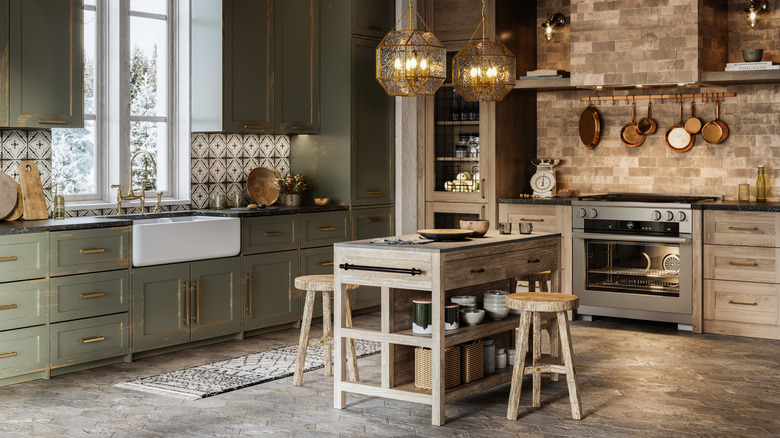How To Use Small Furniture To Style The Victorian-Style Kitchen Of Your Dreams
The Victorian era, which spanned from about 1820 to 1914, was a time of prolific invention and modern development. Perhaps nowhere was this booming technology more prevalent than in the kitchen. Previously, people had relied on buckets of well water and fireplaces to feed their families, but the invention of indoor plumbing, refrigeration, and cookstoves was instrumental in the development of Victorian kitchens. Today, these appliances are seen as simple necessities, not luxurious investments, and their appearance has become much more streamlined and modern to suit a wide variety of homeowner's decor tastes. But what if you prefer that classic, warm look in your kitchen? Are there ways to capture Victorian vibes without owning a Victorian-style house? Absolutely; You can still create the feeling of a Victorian kitchen by avoiding built-in cabinetry and sticking to smaller, more intricate furniture pieces.
Victorians used smaller furniture pieces in their kitchen not only to save money but also because they were more practical in busy kitchens. Here's how using smaller, more versatile furniture in your kitchen can help you achieve that classic historical look and where to shop for some affordable Victorian-like pieces.
The purpose of furniture in Victorian kitchens
Prior to 1925, less than half of all homes in the United States had electricity, so most people in the Victorian era still depended on candles and fires to light their halls, heat their homes, and cook their food. Victorian kitchens often operated using stoves that burned wood or even coal, although gas stoves were becoming more commonplace. Victorian kitchens also follow an inward orientation, meaning that people would move around the borders of the room and cook on a large table in the center. This is opposite to how most modern kitchens are today, where appliances and countertops typically line the walls with an open space in the center. Today, cooking can easily be a one-person job, but in Victorian times, this inward orientation meant that kitchens could accommodate more people to help with cooking, whether they were household servants, family members, or children.
In short, modern kitchens are built to maximize storage, but Victorian kitchens were built to maximize standing and working space. Instead of having large, built-in cabinets, it made sense to have several small, moveable furniture pieces that could be repaired or replaced when necessary. In a Victorian-style kitchen, you might find one or two large wooden tables in the center of the room, a woodstove in the corner, and racks of pots, pans, and dishes in open shelving or freestanding cupboards along the walls.
How you can get the look
To achieve the classic Victorian vibe, think of simple, versatile, and separate pieces. If you're totally remodeling your kitchen, opt for a gas stove if possible, and use very little built-in cabinetry, instead using long tables, freestanding cupboards, chests of drawers, and visible storage, like this open shelf and hanging pot rack comb from Amazon. In the center of the kitchen, place a table instead of an island — even two tables, if your kitchen is large enough! The Bolangburg counter-height dining table from Ashley Furniture provides a good surface for chopping vegetables or kneading bread, plus some subtle storage underneath. For more food or dish storage, add a freestanding pantry like the Sand & Stable pantry cabinet from Wayfair.
Victorian people may not have owned an excess of kitchenware, but the items they did have were beautiful, useful, and durable. Over time, update your kitchen's cheap, modern items like plastic tools and non-stick pans with sturdy copper, glass, wood, ceramic, and stainless steel options. Don't forget to add a touch of whimsy to your kitchen with a vase of fresh flowers, a delicate tea set, and the scent of freshly baked bread. Victorians were resourceful, so thrifting, secondhand shopping, and repurposing are all great ideas as well.


